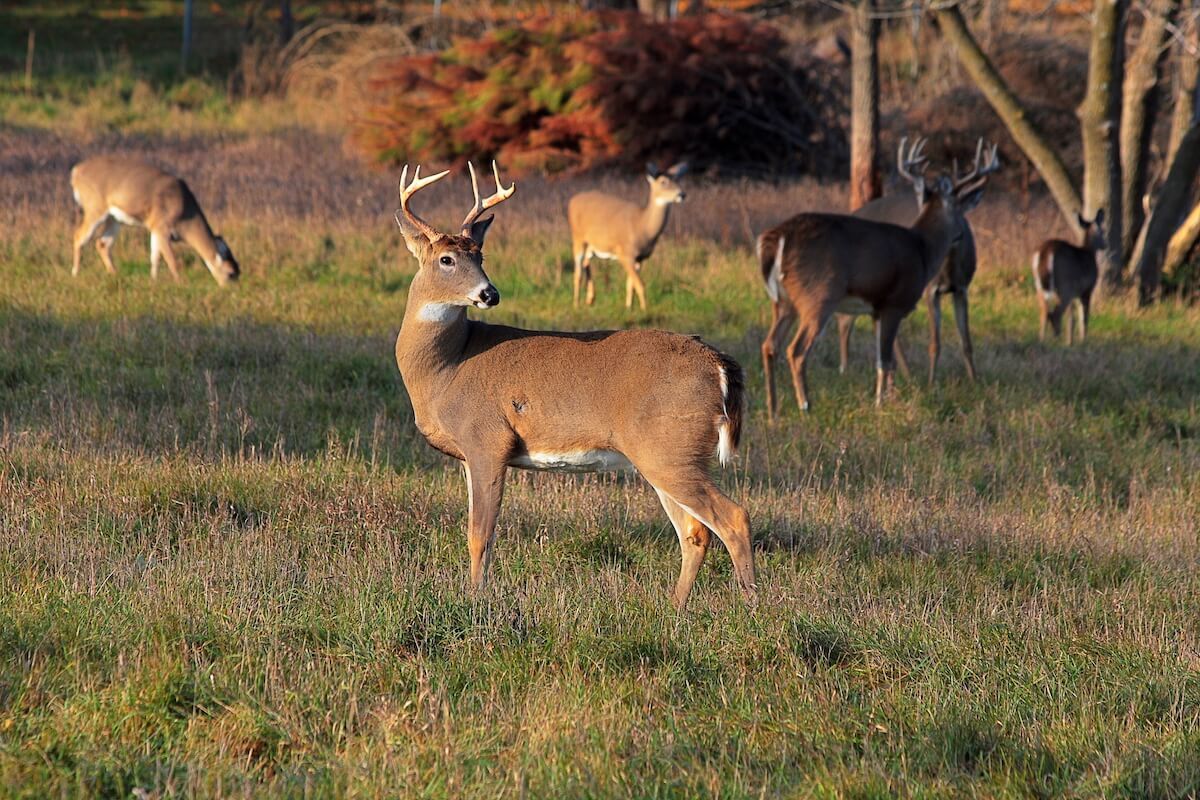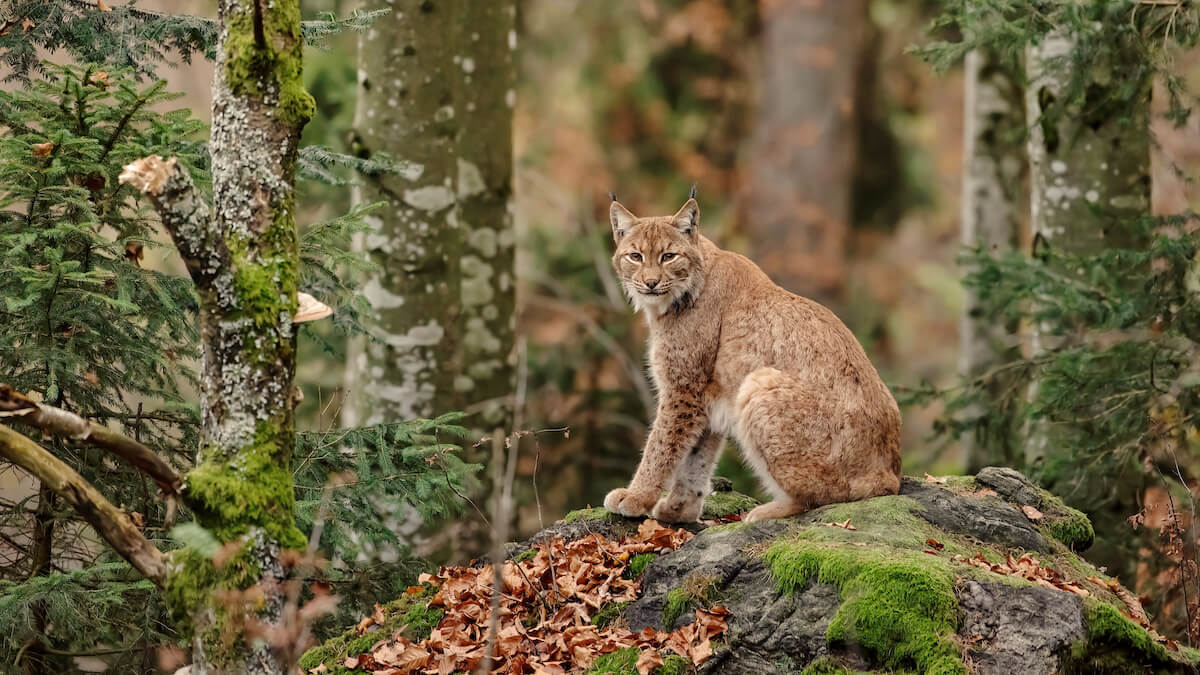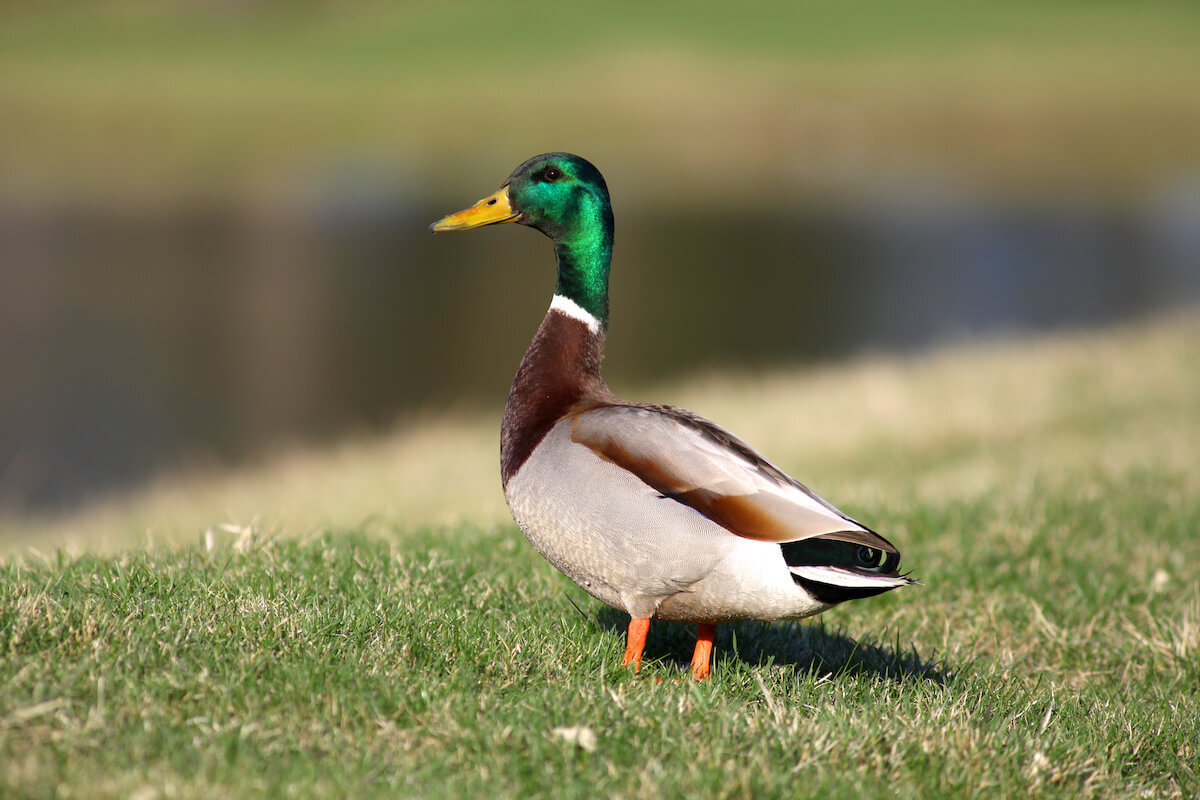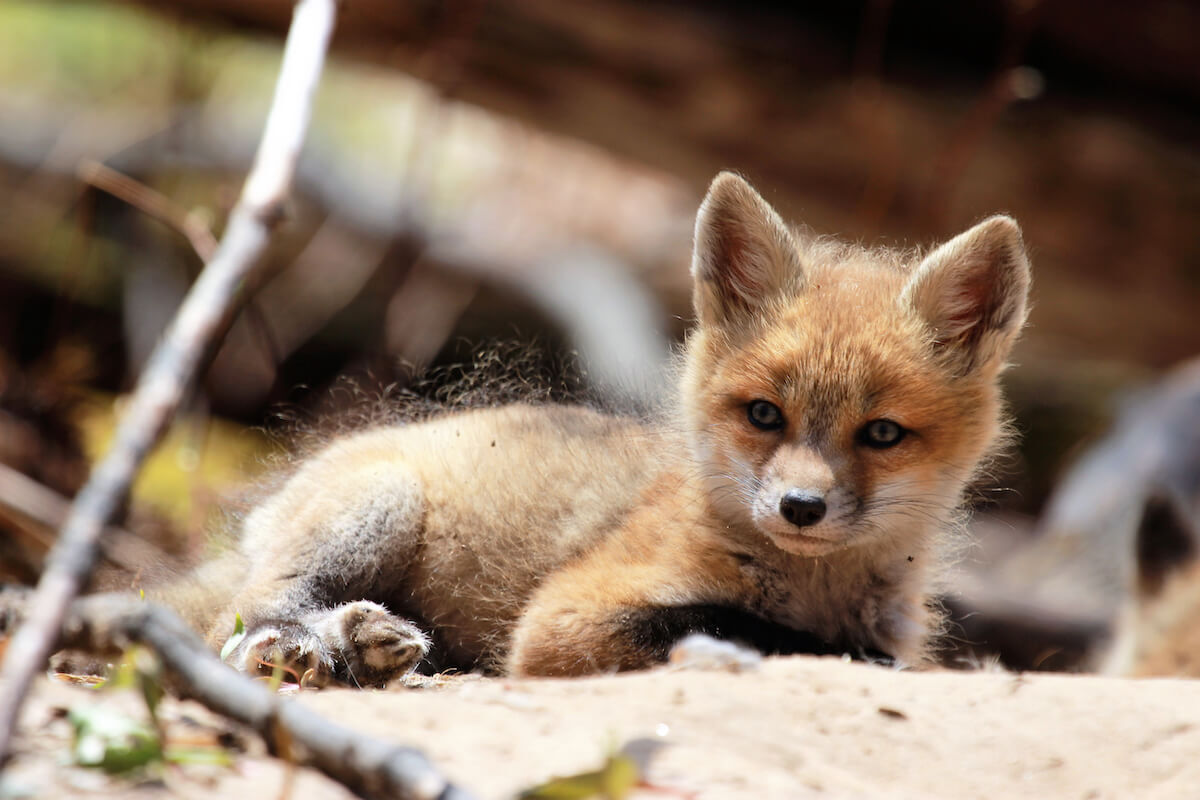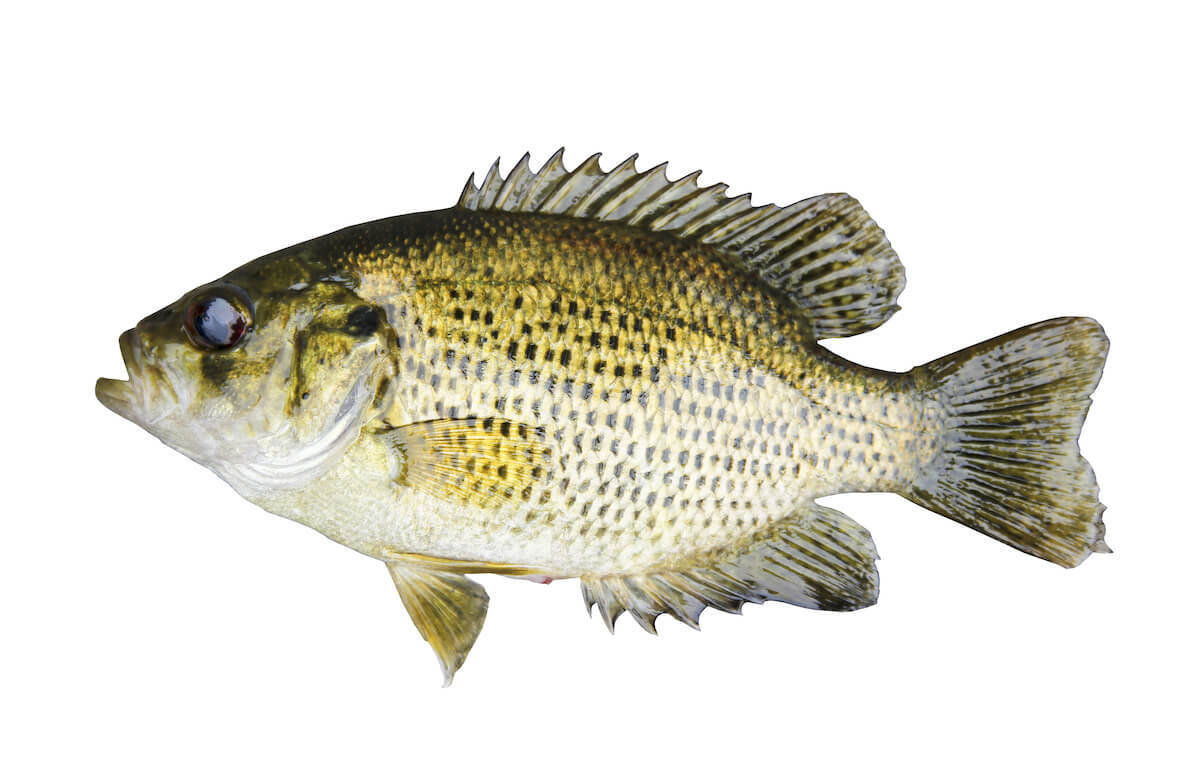Wildlife
Discover the wildlife of Northern Michigan.
White-Tailed DeerThe white-tailed deer (Odocoileus virginianus), also known as the Virginia deer, or simply as the whitetail, is a medium-sized deer native to Northern Michigan.
White-tailed deer are the smallest of the three members of the deer family found in Michigan, the others being elk and moose. They range throughout Michigan and are a game animal in this state. As a species, they extend from the southern edge of the arctic prairies in Canada, all the way to the northern bank of the Amazon River.
"White-tailed" refers to the distinctive white tail that when raised is a flag and provides a flash of white, signaling other deer when there is danger. Deer are graceful and swift runners (up to 35 miles per hour), but do not generally run long distances, preferring to seek the nearest shelter whenever possible. Male deer are called "bucks", females "does" and baby deer "fawns". These deer tend to live in female-led family groups of up to 25 deer and may live to ten years or more.
Their size ranges between 125 to 225 pounds, although really healthy bucks may be even larger. Their coat is a reddish-brown color in the summer, but becomes much more gray in the winter. This change helps to hide them as the colors of their environment change. Their tubular or hollow hairs provide insulation, allowing them to lie on snow without melting it, as well as creating enough buoyancy for swimming.
Read more
The white-tailed deer (Odocoileus virginianus), also known as the Virginia deer, or simply as the whitetail, is a medium-sized deer native to Northern Michigan.
White-tailed deer are the smallest of the three members of the deer family found in Michigan, the others being elk and moose. They range throughout Michigan and are a game animal in this state. As a species, they extend from the southern edge of the arctic prairies in Canada, all the way to the northern bank of the Amazon River.
"White-tailed" refers to the distinctive white tail that when raised is a flag and provides a flash of white, signaling other deer when there is danger. Deer are graceful and swift runners (up to 35 miles per hour), but do not generally run long distances, preferring to seek the nearest shelter whenever possible. Male deer are called "bucks", females "does" and baby deer "fawns". These deer tend to live in female-led family groups of up to 25 deer and may live to ten years or more.
Their size ranges between 125 to 225 pounds, although really healthy bucks may be even larger. Their coat is a reddish-brown color in the summer, but becomes much more gray in the winter. This change helps to hide them as the colors of their environment change. Their tubular or hollow hairs provide insulation, allowing them to lie on snow without melting it, as well as creating enough buoyancy for swimming.
BobcatThe Bobcat (Lynx rufus) is a North American mammal of the cat family, Felidae. With twelve recognized subspecies, it ranges from southern Canada to northern Mexico, including Northern Michigan. The Bobcat is an adaptable predator that inhabits wooded areas, as well as semi-desert, urban edge, forest edges and swampland environments. It persists today in much of its original range and populations are healthy.
With a gray to brown coat, whiskered face, and black-tufted ears, the Bobcat resembles the other species of the mid-sized Lynx genus. It is smaller than the Canadian Lynx, with which it shares parts of its range, but is about twice as large as the domestic cat. It has distinctive black bars on its forelegs and a black-tipped, stubby tail, from which it derives its name.
Though the Bobcat prefers rabbits and hares, it will hunt anything from insects and small rodents to deer. Prey selection depends on location and habitat, season, and abundance. Like most cats, the bobcat is territorial and largely solitary, although there is some overlap in home ranges. It uses several methods to mark its territorial boundaries, including claw marks and deposits of urine or feces. The Bobcat breeds from winter into spring and has a gestation period of about two months.
Although Bobcats have been hunted extensively by humans, both for sport and fur, their population has proven resilient. The elusive predator features in Native American mythology and the folklore of European settlers.
Read more
The Bobcat (Lynx rufus) is a North American mammal of the cat family, Felidae. With twelve recognized subspecies, it ranges from southern Canada to northern Mexico, including Northern Michigan. The Bobcat is an adaptable predator that inhabits wooded areas, as well as semi-desert, urban edge, forest edges and swampland environments. It persists today in much of its original range and populations are healthy.
With a gray to brown coat, whiskered face, and black-tufted ears, the Bobcat resembles the other species of the mid-sized Lynx genus. It is smaller than the Canadian Lynx, with which it shares parts of its range, but is about twice as large as the domestic cat. It has distinctive black bars on its forelegs and a black-tipped, stubby tail, from which it derives its name.
Though the Bobcat prefers rabbits and hares, it will hunt anything from insects and small rodents to deer. Prey selection depends on location and habitat, season, and abundance. Like most cats, the bobcat is territorial and largely solitary, although there is some overlap in home ranges. It uses several methods to mark its territorial boundaries, including claw marks and deposits of urine or feces. The Bobcat breeds from winter into spring and has a gestation period of about two months.
Although Bobcats have been hunted extensively by humans, both for sport and fur, their population has proven resilient. The elusive predator features in Native American mythology and the folklore of European settlers.
BeaverThe beaver (genus Castor) is a primarily nocturnal, large, semi-aquatic rodent. Beavers are known for building dams, canals, and lodges (homes). They are the second-largest rodent in the world (after the capybara). Their colonies create one or more dams to provide still, deep water to protect against predators, and to float food and building material. The North American beaver population was once more than 60 million, but as of 1988 was 6–12 million. This population decline is due to extensive hunting for fur, for glands used as medicine and perfume, and because their harvesting of trees and flooding of waterways may interfere with other land uses.
Beavers are also known for their "danger signal": when startled or frightened, a swimming beaver will rapidly dive while forcefully slapping the water with its broad tail. This creates a loud "slap," audible over great distances above and below water. This noise serves as a warning to beavers in the area. Once a beaver has made this danger signal, nearby beavers dive and may not reemerge for some time. Beavers are slow on land, but good swimmers that can stay under water for as long as 15 minutes.
Beavers do not hibernate, but store sticks and logs in a pile in their pond. Some of the pile is generally above water which accumulates snow in the winter. The insulation of the snow often keeps the water from freezing in and around their food pile which provides a location where beavers can breathe when outside their lodge.
Read more
The beaver (genus Castor) is a primarily nocturnal, large, semi-aquatic rodent. Beavers are known for building dams, canals, and lodges (homes). They are the second-largest rodent in the world (after the capybara). Their colonies create one or more dams to provide still, deep water to protect against predators, and to float food and building material. The North American beaver population was once more than 60 million, but as of 1988 was 6–12 million. This population decline is due to extensive hunting for fur, for glands used as medicine and perfume, and because their harvesting of trees and flooding of waterways may interfere with other land uses.
Beavers are also known for their "danger signal": when startled or frightened, a swimming beaver will rapidly dive while forcefully slapping the water with its broad tail. This creates a loud "slap," audible over great distances above and below water. This noise serves as a warning to beavers in the area. Once a beaver has made this danger signal, nearby beavers dive and may not reemerge for some time. Beavers are slow on land, but good swimmers that can stay under water for as long as 15 minutes.
Beavers do not hibernate, but store sticks and logs in a pile in their pond. Some of the pile is generally above water which accumulates snow in the winter. The insulation of the snow often keeps the water from freezing in and around their food pile which provides a location where beavers can breathe when outside their lodge.
Mallard DuckThe Mallard (Anas platyrhynchos), probably the best-known and most recognizable of all ducks, is a dabbling duck which breeds throughout the temperate and sub-tropical areas of North America, Europe, Asia, Africa, New Zealand (where it is currently the most common duck species), and Australia. It is strongly migratory in the northern parts of its breeding range, and winters farther south. For example, in North America it winters south to Mexico, but also regularly strays into Central America and the Caribbean between September and May.
The breeding male is unmistakable, with a green head, black rear end and a yellowish orange (can also contain some red) bill tipped with black (as opposed to the dark brown bill in females). The female Mallard is light brown, like most female dabbling ducks. However, both the female and male Mallards have distinct purple speculum edged with white, prominent in flight or at rest (though temporarily shedded during the annual summer molt). In non-breeding (eclipse) plumage the drake becomes drab, looking more like the female, but still distinguishable by its yellow bill and reddish breast.
The Mallard inhabits most wetlands, including parks, small ponds and rivers, and usually feeds by dabbling for plant food or grazing; there are reports of it eating frogs. It usually nests on a river bank, but not always near water. It is highly gregarious outside of the breeding season and will form large flocks, which are known as a sord.
Read more
The Mallard (Anas platyrhynchos), probably the best-known and most recognizable of all ducks, is a dabbling duck which breeds throughout the temperate and sub-tropical areas of North America, Europe, Asia, Africa, New Zealand (where it is currently the most common duck species), and Australia. It is strongly migratory in the northern parts of its breeding range, and winters farther south. For example, in North America it winters south to Mexico, but also regularly strays into Central America and the Caribbean between September and May.
The breeding male is unmistakable, with a green head, black rear end and a yellowish orange (can also contain some red) bill tipped with black (as opposed to the dark brown bill in females). The female Mallard is light brown, like most female dabbling ducks. However, both the female and male Mallards have distinct purple speculum edged with white, prominent in flight or at rest (though temporarily shedded during the annual summer molt). In non-breeding (eclipse) plumage the drake becomes drab, looking more like the female, but still distinguishable by its yellow bill and reddish breast.
The Mallard inhabits most wetlands, including parks, small ponds and rivers, and usually feeds by dabbling for plant food or grazing; there are reports of it eating frogs. It usually nests on a river bank, but not always near water. It is highly gregarious outside of the breeding season and will form large flocks, which are known as a sord.
Red FoxThe Red Fox (Vulpes vulpes) is a mammal of the order Carnivora. It has the widest range of any terrestrial carnivore, being native to Canada, Alaska, almost all of the contiguous United States, Europe, North Africa and almost all of Asia, including Japan. In Ireland and the UK, where there are no longer any other native wild canids, it is referred to simply as "the fox". It was introduced into Australia in the 19th century. As its name suggests, its fur is predominantly reddish-brown, but there is a naturally occurring grey morph known as the Silver Fox; a strain of domesticated Silver Fox has been produced from these animals by systematic domestication.
The Red Fox is most commonly a rusty red, with white underbelly, black ear tips and legs, and a bushy tail usually with a distinctive white tip. The "red" tone can vary from dark chestnut to golden, and in fact can be "agouti", with bands of red, brown, black and white on each individual hair. Farmed stock are mostly silver, but may be almost any colour including spotted or blotched with white.
Fox eyes are gold to yellow and have distinctive vertical-slit pupils, similar to those of domestic cats. Their behavior, and eye-slits, combined with their extreme agility for a canid, warrants the Red Fox to be referred to as the "cat-like canine". Its long bushy tail with distinctive white tip provides balance for large jumps and complex movement. Its strong legs allow it to reach speeds of approximately 45 miles per hour, a great benefit to catching prey or evading predators.
Read more
The Red Fox (Vulpes vulpes) is a mammal of the order Carnivora. It has the widest range of any terrestrial carnivore, being native to Canada, Alaska, almost all of the contiguous United States, Europe, North Africa and almost all of Asia, including Japan. In Ireland and the UK, where there are no longer any other native wild canids, it is referred to simply as "the fox". It was introduced into Australia in the 19th century. As its name suggests, its fur is predominantly reddish-brown, but there is a naturally occurring grey morph known as the Silver Fox; a strain of domesticated Silver Fox has been produced from these animals by systematic domestication.
The Red Fox is most commonly a rusty red, with white underbelly, black ear tips and legs, and a bushy tail usually with a distinctive white tip. The "red" tone can vary from dark chestnut to golden, and in fact can be "agouti", with bands of red, brown, black and white on each individual hair. Farmed stock are mostly silver, but may be almost any colour including spotted or blotched with white.
Fox eyes are gold to yellow and have distinctive vertical-slit pupils, similar to those of domestic cats. Their behavior, and eye-slits, combined with their extreme agility for a canid, warrants the Red Fox to be referred to as the "cat-like canine". Its long bushy tail with distinctive white tip provides balance for large jumps and complex movement. Its strong legs allow it to reach speeds of approximately 45 miles per hour, a great benefit to catching prey or evading predators.
Rock BassRock bass are native to fresh water in east-central North America. This heavy bodied member of the sunfish family can be readily distinguished from other similar species by the six spines in the lower fin (other typical sunfishes have only three lower fin spines). These fish are a commercial species in the Great Lakes and are also an important sport fish. They are lively fighters when hooked, and their flesh is firm and delectable.
True to their name, rock bass live in rocky areas in the lake's shallows. Adults live in groups, often associating with smallmouth bass and other similar fish. Spawning takes place in late spring and when water temperatures reach 55 to 60 degrees F. Like other members of the sunfish family, the male digs a nest in the lake shallows, and guards it tenaciously. A spawning area may be heavily used with several nests very close together. As a result, males can become quite aggressive as they attempt to defend territory and attract and hold females. The male guards and fans the eggs, and later broods the young for a short time. Rock bass grow quickly and adults weigh an average of 4 to 8 ounces. An average length is six to eight inches although some rock bass reach 12 inches. Few rock bass live beyond 10 to 12 years.
Large bass, northern pike, muskie, and perhaps walleyes prey on young rock bass. Rock bass compete with smallmouth bass for food. They eat aquatic insects, crayfish, and small fish, including their own young, yellow perch, and minnows. Rock bass occasionally take food from the surface.
Read more
Rock bass are native to fresh water in east-central North America. This heavy bodied member of the sunfish family can be readily distinguished from other similar species by the six spines in the lower fin (other typical sunfishes have only three lower fin spines). These fish are a commercial species in the Great Lakes and are also an important sport fish. They are lively fighters when hooked, and their flesh is firm and delectable.
True to their name, rock bass live in rocky areas in the lake's shallows. Adults live in groups, often associating with smallmouth bass and other similar fish. Spawning takes place in late spring and when water temperatures reach 55 to 60 degrees F. Like other members of the sunfish family, the male digs a nest in the lake shallows, and guards it tenaciously. A spawning area may be heavily used with several nests very close together. As a result, males can become quite aggressive as they attempt to defend territory and attract and hold females. The male guards and fans the eggs, and later broods the young for a short time. Rock bass grow quickly and adults weigh an average of 4 to 8 ounces. An average length is six to eight inches although some rock bass reach 12 inches. Few rock bass live beyond 10 to 12 years.
Large bass, northern pike, muskie, and perhaps walleyes prey on young rock bass. Rock bass compete with smallmouth bass for food. They eat aquatic insects, crayfish, and small fish, including their own young, yellow perch, and minnows. Rock bass occasionally take food from the surface.
MooseThe moose (Alces alces) is the largest extant species in the deer family. Moose are distinguished by the palmate antlers of the males.
In North America, the moose range includes almost all of Canada, most of central and western Alaska, much of New England and upstate New York, the upper Rocky Mountains, Northeastern Minnesota, and Michigan's Upper Peninsula and Isle Royale in Lake Superior. Isolated moose populations have been verified as far south as the mountains of Utah and Colorado. In 1978 a few breeding pairs were introduced in western Colorado, and the state's moose population is now more than 1,000.
Moose were once common in the Northern Lower and Upper Peninsulas. By 1900, moose were extirpated in the Lower Peninsula and if not in the Upper Peninsula, at the very least, the population was substantially reduced. Although it is not clear how they got there, by 1930, the number of Moose on Isle Royale had increased to an estimated 3000 animals. In 1934-37, the Michigan Department of Conservation undertook a project to reduce moose numbers on Isle Royale and replenish the mainland UP moose herd with animals from Isle Royale.
Read more
The moose (Alces alces) is the largest extant species in the deer family. Moose are distinguished by the palmate antlers of the males.
In North America, the moose range includes almost all of Canada, most of central and western Alaska, much of New England and upstate New York, the upper Rocky Mountains, Northeastern Minnesota, and Michigan's Upper Peninsula and Isle Royale in Lake Superior. Isolated moose populations have been verified as far south as the mountains of Utah and Colorado. In 1978 a few breeding pairs were introduced in western Colorado, and the state's moose population is now more than 1,000.
Moose were once common in the Northern Lower and Upper Peninsulas. By 1900, moose were extirpated in the Lower Peninsula and if not in the Upper Peninsula, at the very least, the population was substantially reduced. Although it is not clear how they got there, by 1930, the number of Moose on Isle Royale had increased to an estimated 3000 animals. In 1934-37, the Michigan Department of Conservation undertook a project to reduce moose numbers on Isle Royale and replenish the mainland UP moose herd with animals from Isle Royale.

